Overview
The article titled “10 Essential Insights on Union Membership Cards for Leaders” underscores the crucial and multifaceted role that union membership cards play in enhancing member engagement and organizational effectiveness. These cards are not merely symbols of belonging and access to benefits; they are vital tools for recruitment, participation monitoring, and adapting to legal and technological changes. By effectively utilizing these cards, union leadership can foster a stronger sense of community and commitment among members.
Furthermore, understanding the diverse functions of membership cards can empower union leaders to implement strategies that enhance member involvement. For instance, these cards can facilitate easier access to resources, encourage participation in union activities, and serve as a means of tracking engagement levels. In addition, as the landscape of union operations evolves, adapting membership card usage to meet new challenges will be essential in maintaining relevance and effectiveness.
Ultimately, the strategic application of union membership cards can lead to increased member satisfaction and loyalty. By recognizing their importance and potential, union leaders can take actionable steps to leverage these tools for greater organizational success. Thus, it is imperative for union leadership to prioritize the effective management and utilization of membership cards to foster a thriving union environment.
Introduction
Union membership cards are essential instruments that extend beyond mere identification; they are pivotal in cultivating community, enhancing engagement, and navigating the dynamic landscape of labor organization. These cards not only signify belonging but also unlock a multitude of benefits that can profoundly influence collective bargaining power and member representation. As the legal landscape shifts and technology evolves, how can unions ensure these crucial tools remain relevant and effective? Examining the multifaceted roles of membership cards unveils both the opportunities and challenges ahead for union leaders committed to fostering strong connections with their members.
Furthermore, the exploration of these roles reveals the pressing need for union leadership to adapt and innovate. The landscape of labor organization is in constant flux, and membership cards must evolve to meet the changing needs of members. By embracing technology and understanding the implications of legal changes, unions can enhance the effectiveness of these tools. In addition, the benefits associated with membership cards can significantly bolster collective bargaining efforts, making it imperative for union leaders to recognize and leverage these advantages.
In conclusion, the future of union membership cards hinges on the proactive strategies implemented by union leadership. By addressing the challenges and seizing the opportunities presented by these essential tools, unions can strengthen their bonds with members and enhance their overall effectiveness in representing their interests.
Votem: Secure Online Voting Solutions for Union Elections
Votem’s CastIron platform stands as a formidable solution for labor elections, ensuring strict compliance with critical regulations such as NCUA and DOL. By facilitating secure online voting, organizations can significantly enhance participation and simplify the election process. This ultimately promotes greater involvement and trust among individuals, essential for fostering a robust electoral environment.
Furthermore, the platform’s mobile-first design empowers users to vote effortlessly from any location, a necessity for contemporary organizational operations. Votem’s unwavering commitment to enhancing accessibility is evident in its ability to cater to all voters, including those with disabilities and military personnel, ensuring that every voice is heard and valued.
In addition, with a proven track record of managing substantial vote counts, such as the impressive 299,000 votes for the National Radio Hall of Fame, Votem demonstrates its capability to conduct elections effectively and transparently. This innovative approach not only boosts voter confidence but also reinforces the integrity of the electoral process, establishing a foundation for trust and reliability in union elections.
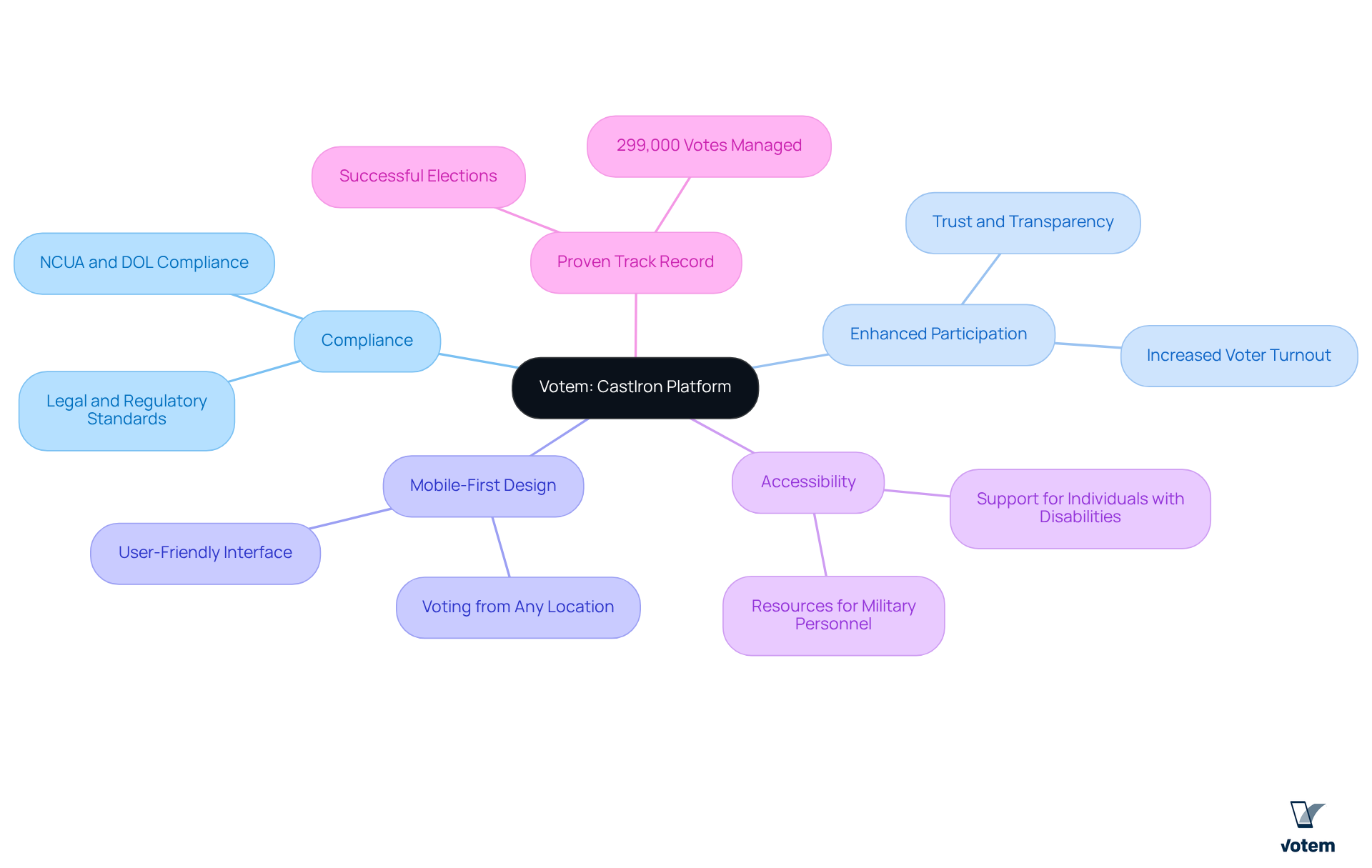
Trade Union Membership Cards: More Than Just a Card
Membership certificates of trade organizations are essential symbols of belonging and dedication. They not only recognize participants but also grant access to a range of benefits and services. By promoting a sense of community and belonging, these materials significantly enhance member involvement, which is vital for fostering collective solidarity. Furthermore, they can be effectively utilized to monitor participation in collective activities and initiatives, ensuring that all members are engaged and contributing to the union’s goals.
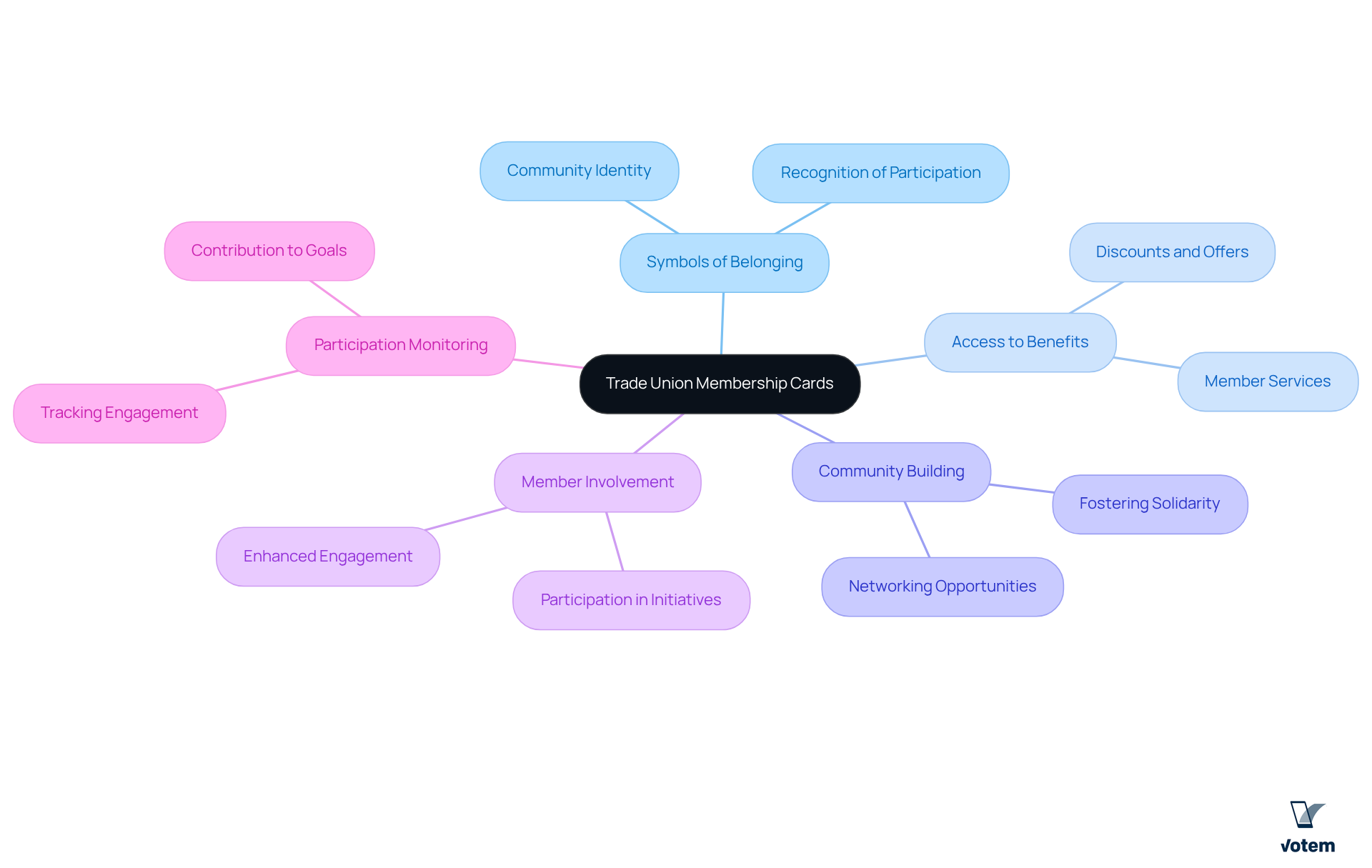
Legal Considerations for Union Membership Cards Post-Janus
The Janus v. AFSCME decision has profound implications for collective organization identification, particularly concerning fee collection and the representation of non-members. Unions are now required to ensure that their union membership cards explicitly delineate the rights and responsibilities of individuals, reflecting a new legal landscape where public sector employees can opt out of paying union dues. This transformation mandates a comprehensive review of membership agreements to guarantee compliance with the ruling, alongside the creation of effective communication strategies that foster transparency.
Unions must actively seek affirmative consent from employees prior to collecting dues. This requirement presents challenges but also opens avenues for enhancing member engagement. Notably, the ruling has led to an estimated loss of over one million workers and approximately $700 million in annual revenue for government associations, underscoring the financial ramifications of these changes.
Furthermore, Justice Alito’s proposal of a fee-for-service model presents a distinct approach for labor organizations to adapt to the evolving legal environment. By integrating these strategies and prioritizing clear communication, labor organizations can adeptly navigate the complexities introduced by the Janus decision and sustain their influence in advocating for workers’ interests.
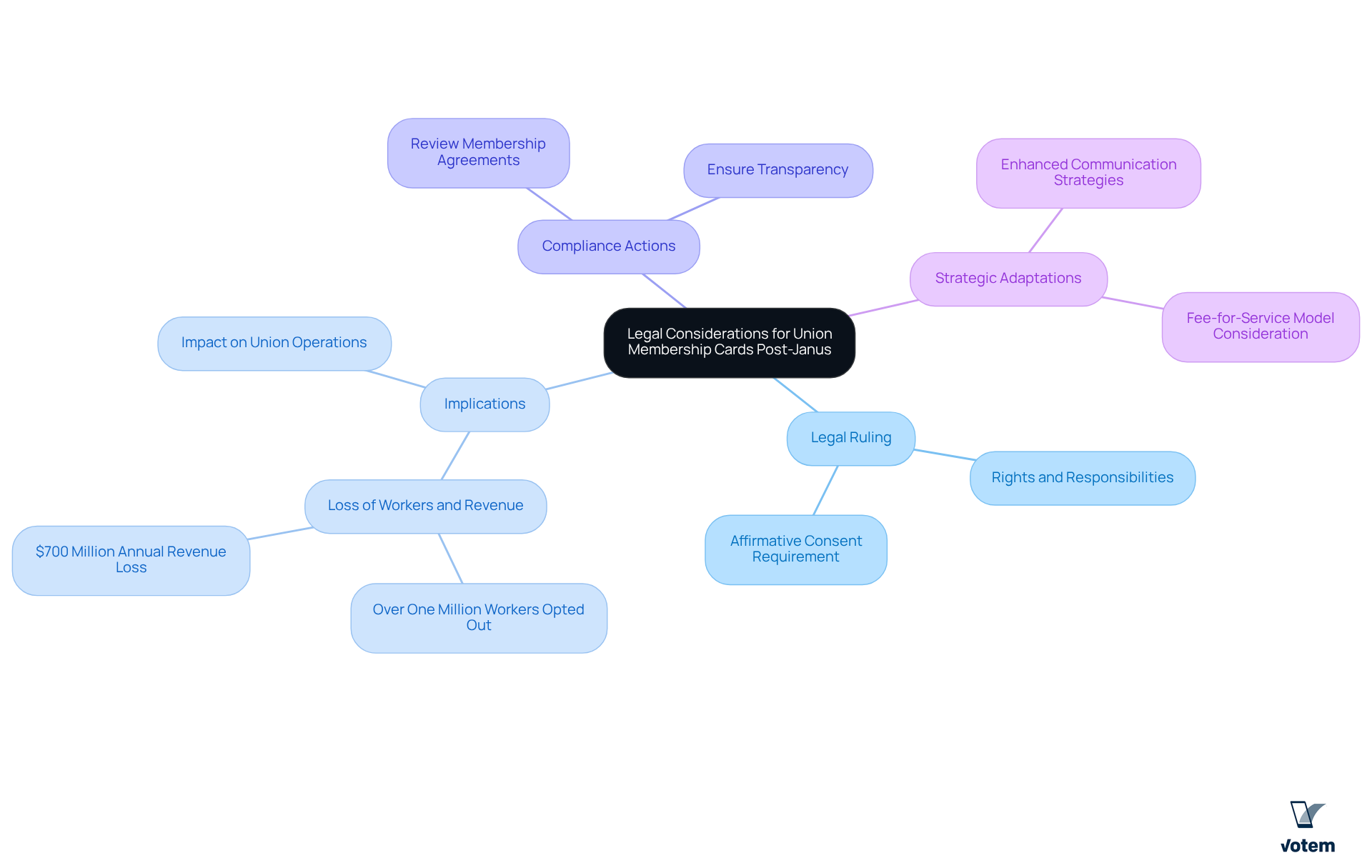
Benefits of Union Membership: Access and Representation
Union membership offers a multitude of benefits, prominently featuring access to collective bargaining, a crucial mechanism for enhancing workplace conditions. Through collective negotiations, labor members typically secure better wages, improved job security, and superior benefits compared to their non-labor counterparts. Notably, collective workers earn approximately 18% more than their non-collective peers, translating to nearly $10,000 in additional yearly income. This financial advantage is particularly significant among marginalized communities, with Black workers earning 26% more and Hispanic workers 39.2% more when part of an organized collective.
Furthermore, collective bargaining acts as a formidable tool for addressing workplace inequalities. Union agreements ensure equal compensation for similar work, protecting individuals from biases related to gender, sexual orientation, or race. This unwavering commitment to fairness not only cultivates a more equitable work environment but also enhances overall job satisfaction and retention.
By effectively communicating these benefits, labor organizations can attract new members and reinforce the importance of solidarity and collective action through the distribution of union membership cards. The growing public support for labor organizations, evidenced by an increase in representation petitions, underscores the recognition of these advantages among workers. As labor leadership, emphasizing the tangible results of collective bargaining can significantly boost membership involvement and commitment.
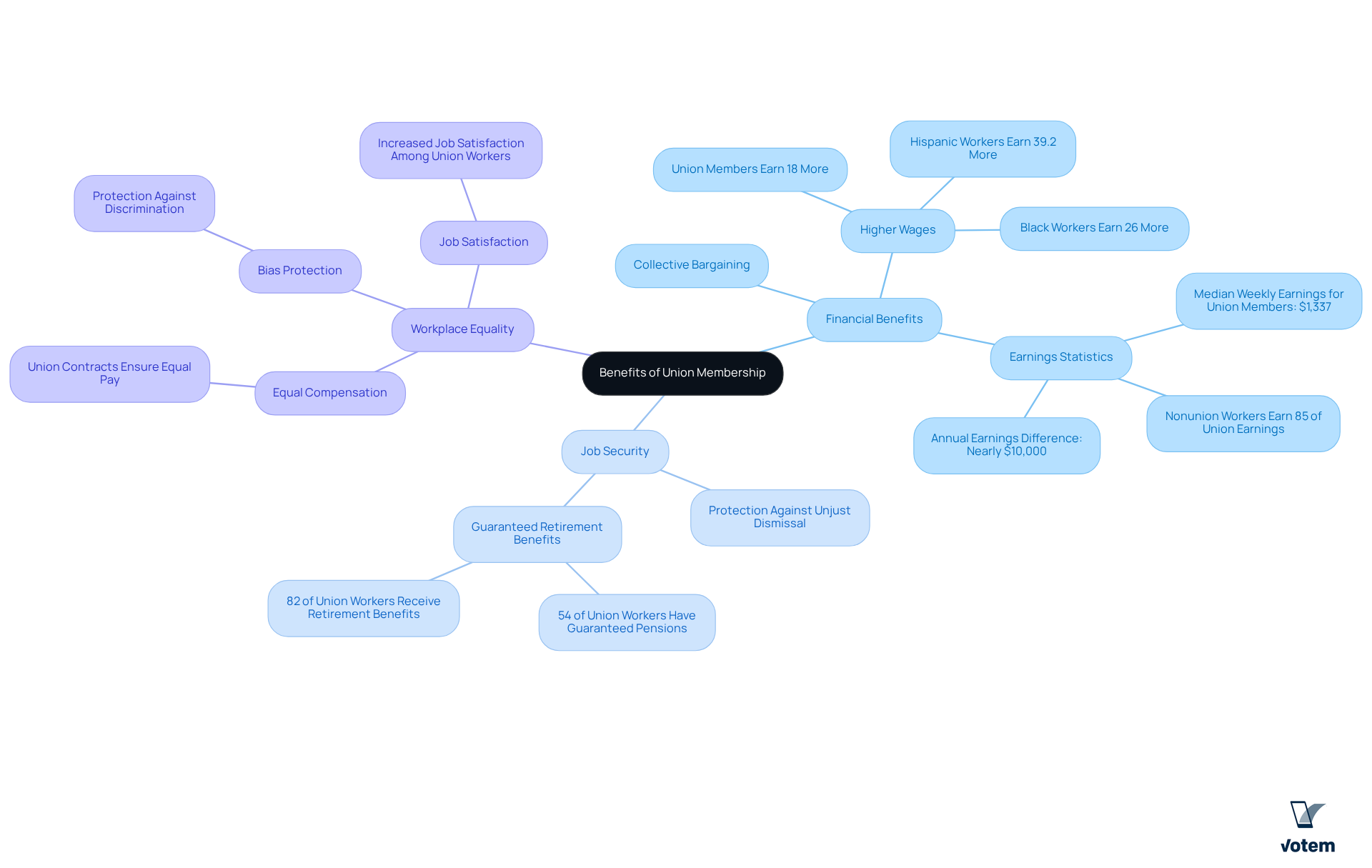
Organizing Tools: Enhancing Recruitment with Membership Cards
Union membership cards play a pivotal role in the recruitment and organizing initiatives for labor groups. By distributing these materials at outreach events and informational sessions, organizations forge a tangible connection with prospective individuals, fostering a sense of belonging. Furthermore, the incorporation of QR codes on union membership cards significantly enhances this engagement. These codes provide immediate access to essential association resources, updates, and information, facilitating connections for new participants from the outset.
In 2025, the anticipated use of QR codes in association identification is expected to promote greater engagement rates, as they streamline communication and interaction. This innovative approach not only simplifies the onboarding process but also empowers individuals to actively participate in organizational activities through union membership cards, thereby reinforcing their commitment to shared objectives. As highlighted by industry specialists, the effectiveness of affiliation tools in organizing initiatives is markedly improved when they incorporate digital functionalities. This ensures that organizations remain relevant and responsive to the evolving needs of their participants.
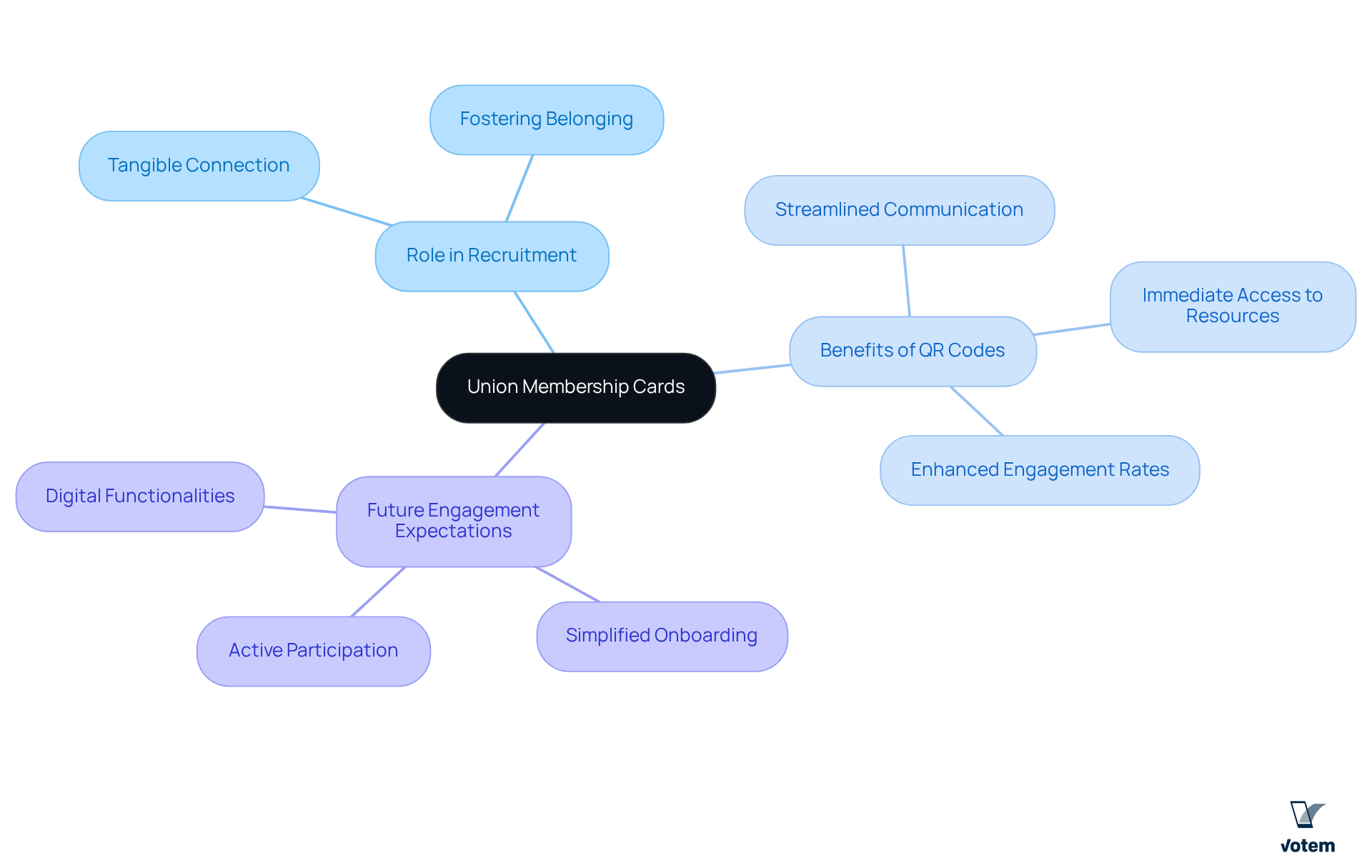
Digital Membership Cards: The Future of Union Identification
Digital identification solutions are swiftly gaining traction among organizations, offering significant advantages in terms of safety and user-friendliness. These documents can be updated instantly, with revisions occurring approximately every 30 days, which enables organizations to manage participant information more efficiently. The auto-expiration feature enhances security and compliance with organizational policies, empowering groups to exercise tighter control over temporary memberships and ensuring effective resource access management.
Furthermore, digital cards seamlessly integrate with mobile wallets, allowing individuals immediate access to their benefits and resources. This modernization not only streamlines administrative processes but also resonates with younger individuals who increasingly favor digital solutions. As younger generations join associations, the demand for digital-first services has become essential for competitive recruitment and retention.
Additionally, the integration of dynamic QR codes bolsters security and functionality, facilitating real-time updates without altering the code. A practical illustration of this is the CPSU/CSA enrollment launch, which provides participants with convenient access to their account information and discounts.
By embracing digital identification tools, organizations can enhance operational efficiency, boost participant engagement, and foster a culture of transparency and trust. Union leaders are compelled to advocate for the adoption of digital identification tools to remain competitive and meet the evolving needs of their constituents.
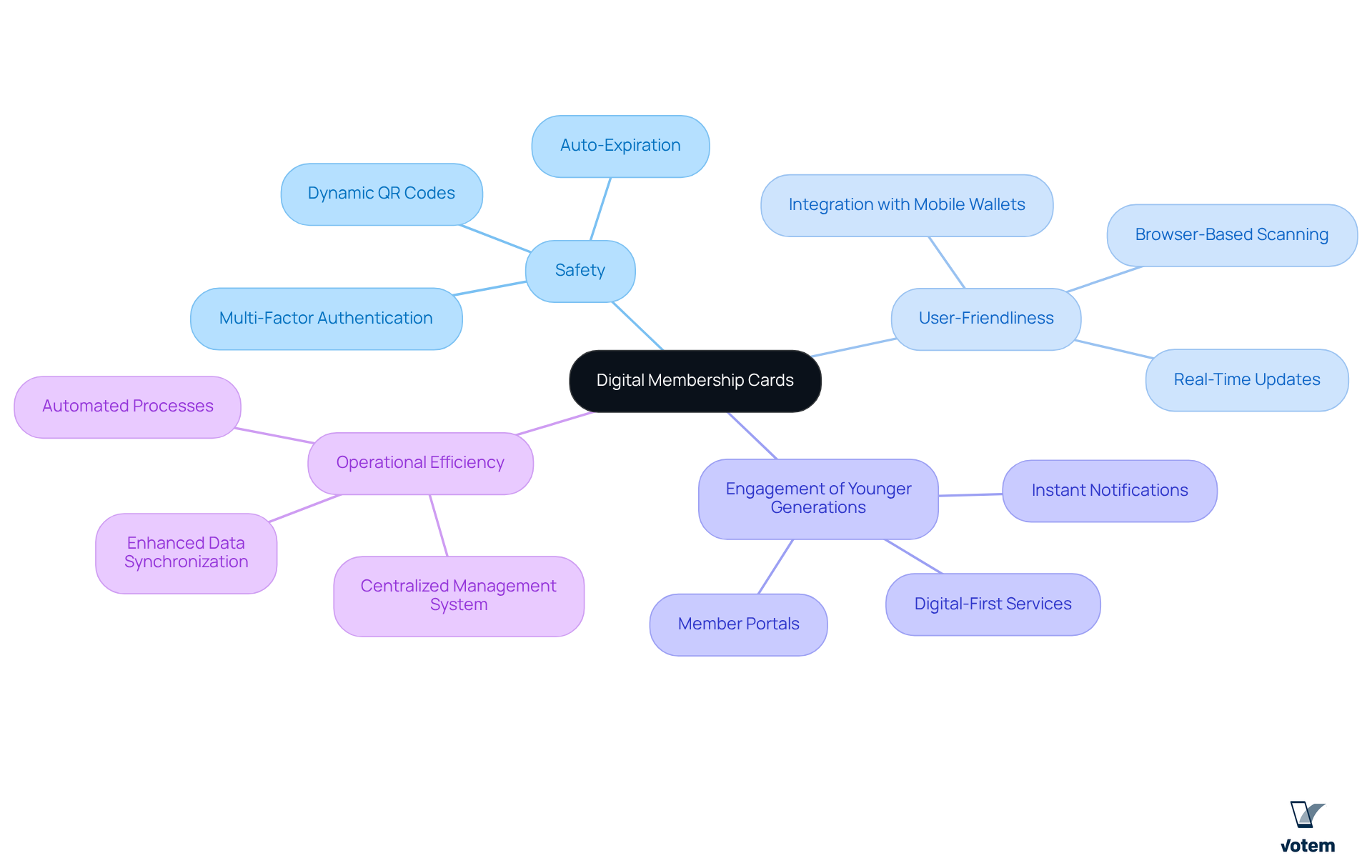
Member Engagement: The Role of Membership Cards in Union Activities
Union membership cards play a pivotal role in enhancing participant involvement within unions. By providing seamless access to events, meetings, and resources, these tools actively encourage engagement among members. For instance, organizations that implement identification passes for event tracking report significantly higher attendance rates, as participants are more likely to engage when their contributions are recognized and rewarded. Furthermore, features such as participation rewards not only incentivize involvement but also cultivate a stronger sense of community and solidarity among members.
Data indicates that associations leveraging enrollment tools experience a notable increase in participation rates, underscoring the critical nature of these resources in fostering an engaged and dynamic membership base. Additionally, organizations that adopt digital access tools can reduce operational costs by up to 40%, thereby enhancing the efficiency of union operations. The convenience of immediate access to benefits through digital platforms shortens wait times for newcomers, facilitating their prompt involvement.
Moreover, with 76% of individuals preferring brands that offer personalized experiences, loyalty programs can be tailored to meet the unique needs of participants, thus improving overall satisfaction. Ultimately, by tracking attendance at events, organizations can evaluate the popularity of their activities, ensuring they continue to align with participant interests and drive engagement. This approach not only enhances member involvement with union membership cards but also strengthens the overall effectiveness of union initiatives.
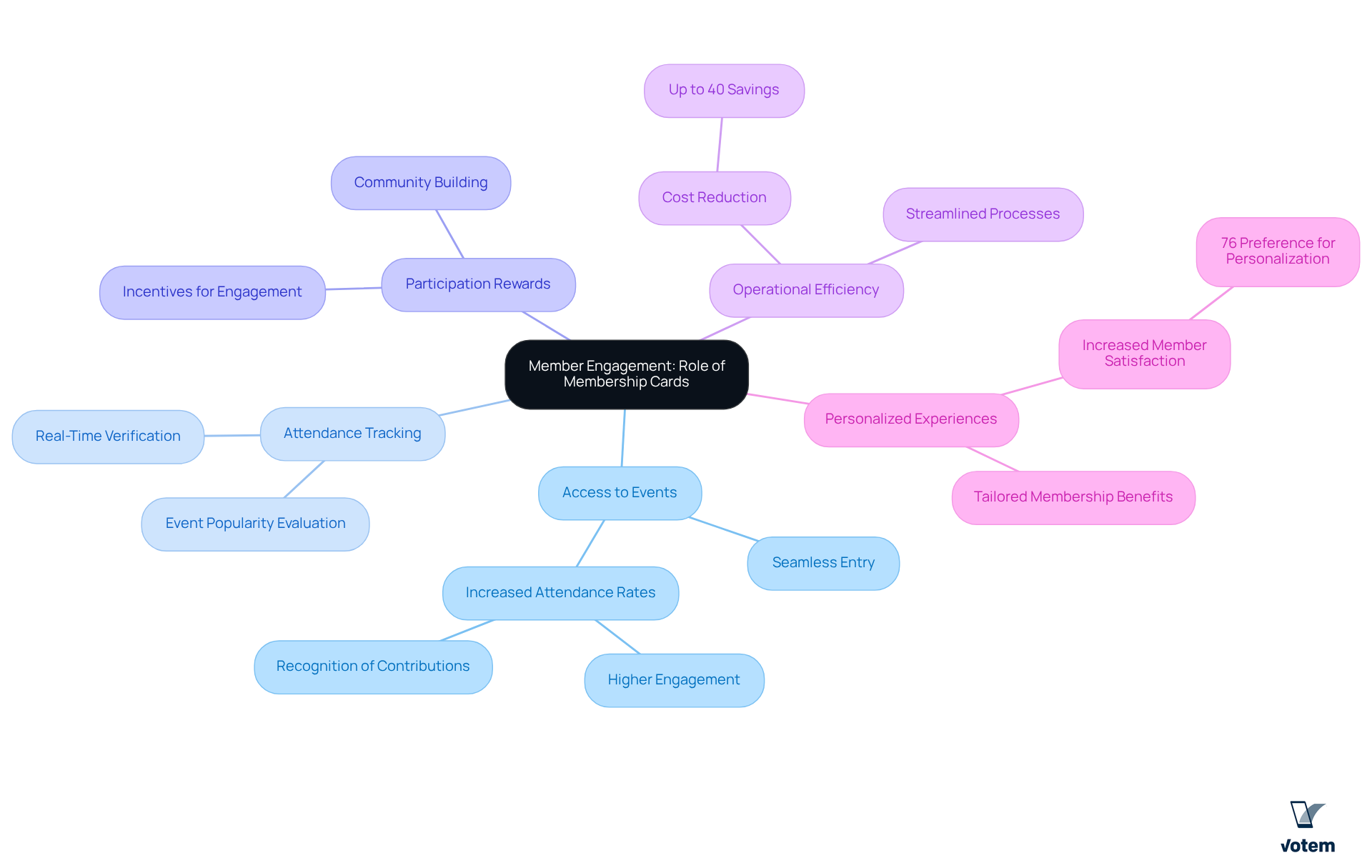
Administrative Management of Union Membership Cards
Efficient administrative oversight of collective affiliation identifiers is essential for preserving accurate participant records and ensuring compliance with regulations. Unions must implement robust systems for tracking the issuance, renewals, and expirations of union membership cards. By utilizing management software, these processes can be simplified, allowing leaders to focus on engagement and advocacy rather than administrative tasks. For instance, the adoption of digital ID systems not only improves security but also enhances compliance, featuring automatic expiration dates that assist organizations in meeting regulatory standards for recertification.
Furthermore, consider this: data indicates that 95% of collective workers have access to employer-sponsored retirement benefits, compared to only 70% of non-collective workers. This statistic underscores the importance of efficient management in securing valuable advantages for individuals. By leveraging technology, organizations can enhance operational efficiency while cultivating a more engaged and informed membership base with the use of union membership cards. The call to action is clear: embrace these advancements to ensure that union leadership can navigate the complexities of modern administration effectively.
![]()
Security Features: Protecting Member Information in Union Cards
In today’s digital environment, protecting individual information is not just important; it is essential for organizations. Membership cards must integrate cutting-edge security features, including encryption and biometric authentication, to effectively safeguard sensitive data, particularly for union membership cards.
For instance, data breaches have quadrupled from 662 in 2010 to 2,850 in 2024, underscoring the urgent need for robust security measures.
- Encryption secures data both at rest and in transit.
- Biometric authentication adds an extra layer of security by ensuring that only authorized individuals can access their information.
- Furthermore, with 88% of web application attacks utilizing stolen credentials, implementing strong security features like multi-factor authentication is imperative.
By prioritizing these advanced security measures, organizations not only adhere to regulations but also significantly enhance trust among their constituents. This commitment to data protection fosters a safer environment, reassuring individuals that their personal information is secure and managed responsibly.
Union leadership should consider conducting regular security audits to assess and strengthen their data protection strategies, particularly for the security of union membership cards.
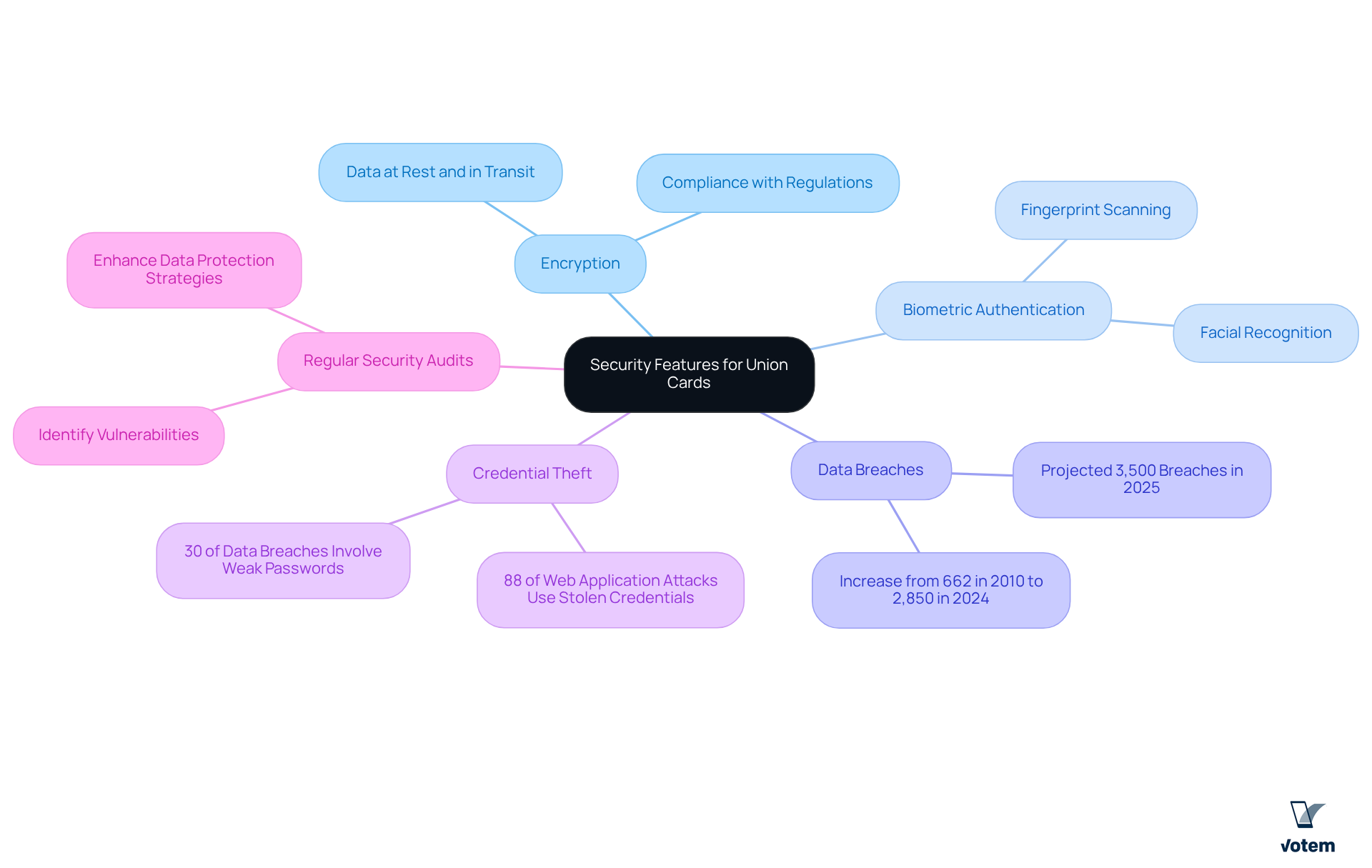
Evolving Landscape: Adapting Union Membership Cards for Modern Needs
To efficiently address the evolving needs of collective participants, the design and utility of membership credentials must advance. Unions should prioritize features that align with contemporary expectations, such as:
- Mobile compatibility
- Real-time updates
- Seamless integration with social media platforms
Digital IDs, for instance, can significantly enhance participant engagement by providing rapid access to organizational resources and enabling direct communication through holder messaging systems. These systems allow organizations to send crucial notifications and updates directly to participants’ digital ID displays. Furthermore, integrating auto-expiration features can simplify renewal procedures by notifying individuals as expiration dates approach. By adopting these modern tools, organizations can foster stronger connections with their constituents, ensuring that identification documents serve as valuable resources for involvement and representation.
As one expert noted, “Interest in union organizing is surging in the United States,” underscoring the necessity of adapting union membership cards to meet member needs in a rapidly changing environment.
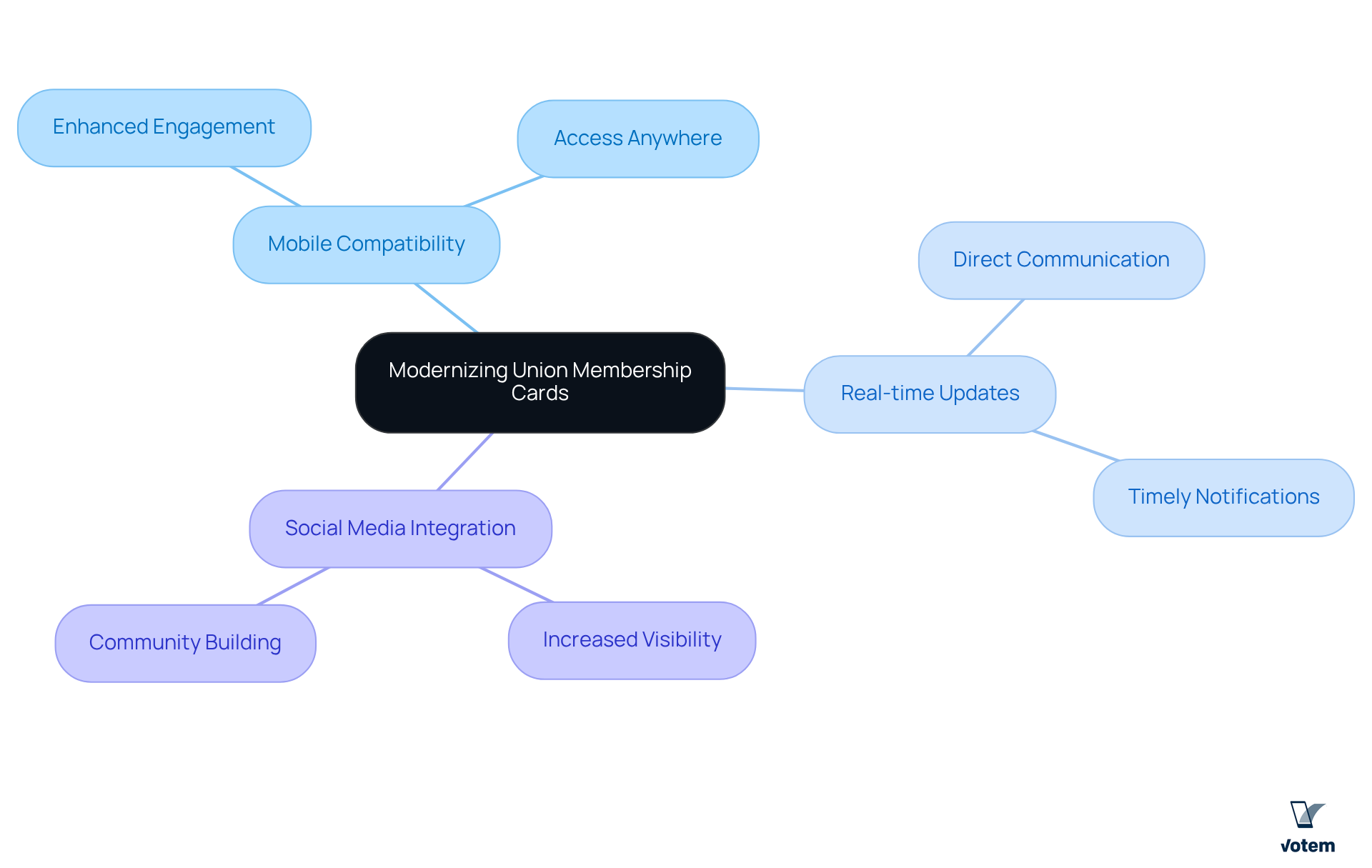
Conclusion
Union membership cards are essential instruments for leaders, encapsulating the core values of belonging, engagement, and representation within labor organizations. These cards transcend mere identification; they embody commitment and grant access to a multitude of benefits that enrich members’ experiences and promote solidarity. As unions confront the complexities of modern membership dynamics, the strategic utilization of these cards becomes increasingly pivotal in reinforcing community connections and ensuring active participation.
The article underscores several critical dimensions of union membership cards, including their function in:
- Facilitating secure online voting
- Adapting to legal shifts post-Janus
- Enhancing member engagement through digital innovations
The insights presented highlight the necessity of effective communication, robust administrative practices, and the integration of security features to safeguard member information. Furthermore, the evolving landscape of union membership compels organizations to embrace innovative tools and technologies to align with the expectations of contemporary members.
In light of these insights, union leaders must prioritize the development and management of membership cards as a strategy to fortify their organizations. By harnessing the advantages of digital solutions and ensuring compliance with legal standards, unions can elevate member engagement, enhance operational efficiency, and cultivate a culture of trust and transparency. The commitment to evolving these indispensable tools will not only bolster membership involvement but also secure the future of collective representation in an ever-evolving labor landscape.
Frequently Asked Questions
What is Votem’s CastIron platform used for?
Votem’s CastIron platform is a secure online voting solution specifically designed for labor elections, ensuring compliance with regulations such as NCUA and DOL.
How does Votem enhance voter participation in elections?
Votem enhances voter participation by facilitating secure online voting, which simplifies the election process and promotes greater involvement and trust among individuals.
What features make Votem’s platform user-friendly?
The platform’s mobile-first design allows users to vote effortlessly from any location, catering to contemporary organizational needs.
How does Votem ensure accessibility for all voters?
Votem’s commitment to accessibility is evident in its ability to cater to all voters, including individuals with disabilities and military personnel, ensuring that every voice is heard and valued.
What is Votem’s track record in managing vote counts?
Votem has a proven track record of managing substantial vote counts, such as handling 299,000 votes for the National Radio Hall of Fame, demonstrating its capability to conduct elections effectively and transparently.
Why are trade union membership cards important?
Trade union membership cards are essential symbols of belonging and dedication, recognizing participants and granting access to benefits and services while promoting community and member involvement.
What legal implications did the Janus v. AFSCME decision have for union membership cards?
The Janus v. AFSCME decision requires unions to ensure that membership cards clearly outline the rights and responsibilities of individuals, as public sector employees can opt out of paying union dues.
What challenges do unions face post-Janus regarding fee collection?
Unions must now seek affirmative consent from employees before collecting dues, presenting challenges but also opportunities for enhancing member engagement.
What financial impact has the Janus decision had on unions?
The Janus decision has led to an estimated loss of over one million workers and about $700 million in annual revenue for government associations.
What alternative model has been proposed for labor organizations in response to the Janus ruling?
Justice Alito proposed a fee-for-service model as a distinct approach for labor organizations to adapt to the evolving legal environment.
List of Sources
- Votem: Secure Online Voting Solutions for Union Elections
- 4 Strategies for Voting Online in Union Elections | Online Voting with Votem® (https://votem.com/4-strategies-for-voting-online-in-union-elections)
- Census Bureau Voting Data Highlights Turnout-Boosting Power of Vote at Home Systems – National Vote at Home Institute (https://voteathome.org/census-bureau-voting-data-highlights-turnout-boosting-power-of-vote-at-home-systems)
- 7 Strategies to Engage Union Voters Effectively | Online Voting with Votem® (https://votem.com/7-strategies-to-engage-union-voters-effectively)
- Electing Union Officers Using Remote Electronic Voting Systems (https://dol.gov/agencies/olms/compliance-assistance/tips/remote-electronic-voting-systems)
- 8 Key Steps for Secure Votation in Union Elections | Online Voting with Votem® (https://votem.com/8-key-steps-for-secure-votation-in-union-elections)
- Trade Union Membership Cards: More Than Just a Card
- 16 million workers were unionized in 2024: Millions more want to join unions but couldn’t (https://epi.org/publication/millions-of-workers-millions-of-workers-want-to-join-unions-but-couldnt)
- Trade Union Membership Cards for the Modern Era — ORGiD (https://orgid.app/blog/trade-union-membership-cards-for-the-modern-era)
- Industrial Union to switch to a fully mobile membership card – members keep all benefits – Teollisuusliitto (https://teollisuusliitto.fi/en/2024/09/industrial-union-to-switch-to-a-fully-mobile-membership-card-members-keep-all-benefits)
- A Brief Examination of Union Membership Data (https://congress.gov/crs-product/R47596)
- Legal Considerations for Union Membership Cards Post-Janus
- Janus had a large impact on union membership, five years later (https://mackinac.org/blog/2023/janus-had-a-large-impact-on-union-membership-five-years-later)
- What the Supreme Court Justices Say: Quotes From the ‘Janus’ Ruling (https://edweek.org/policy-politics/what-the-supreme-court-justices-say-quotes-from-the-janus-ruling/2018/06)
- Four Key Points From Justice Samuel Alito’s Far-Reaching Janus Decision That Overturns 41-Year-Old Precedent on Agency Fees (https://the74million.org/article/four-key-points-from-justice-samuel-alitos-far-reaching-janus-decision)
- New Report Shows Large Drop in Union Membership Five Years After Janus Decision (https://mackinac.org/30997)
- Benefits of Union Membership: Access and Representation
- The union difference in wages – 18% higher pay if you belong to a union (https://afscme.org/blog/the-union-difference-in-wages-18-higher-pay-if-you-belong-to-a-union)
- Union Facts: The Value of Collective Voice | AFL-CIO (https://aflcio.org/formaunion/collective-voice)
- Weekly earnings of nonunion workers were 85 percent of union members’ earnings in 2024 (https://bls.gov/opub/ted/2025/weekly-earnings-of-nonunion-workers-were-85-percent-of-union-members-earnings-in-2024.htm)
- How Unions Are Crucial for Building Working-Class Economic Power (https://americanprogress.org/article/how-unions-are-crucial-for-building-working-class-economic-power)
- Organizing Tools: Enhancing Recruitment with Membership Cards
- Union Organizing Software | Mobilize & Grow Membership (https://unionimpact.com/blog/union-organizing-software)
- Trade Union Membership Cards for the Modern Era — ORGiD (https://orgid.app/blog/trade-union-membership-cards-for-the-modern-era)
- A Brief Examination of Union Membership Data (https://congress.gov/crs-product/R47596)
- Organizing Tools – Union 101 | NEA (https://nea.org/resource-library/organizing-tools-union-101)
- Union Members Summary
- 2024 A01 Results (https://bls.gov/news.release/union2.nr0.htm)
- Digital Membership Cards: The Future of Union Identification
- CWA Digital Membership Card FAQ (https://cwa-union.org/cwa-digital-membership-card-faq)
- The Importance Of Digital Member Portals For Modern Unions – Union Impact Software (https://unionimpact.com/blog/the-importance-of-digital-member-portals-for-modern-unions)
- Trade Union Membership Cards for the Modern Era — ORGiD (https://orgid.app/blog/trade-union-membership-cards-for-the-modern-era)
- Digital Membership Card (https://cpsucsa.org/digital_membership_card)
- Member Engagement: The Role of Membership Cards in Union Activities
- Top Member Engagement Trends for 2025 (https://glueup.com/blog/member-engagement-trends-2025)
- How Membership Cards Can Increase Loyalty and Engagement (https://joinit.com/blog/how-membership-cards-can-increase-loyalty-and-engagement)
- Boost Retention with Digital Membership Cards • Glue Up (https://glueup.com/blog/digital-membership-cards-retention-engagement)
- 36 Useful Membership Site Statistics You Should Know (2021) (https://memberpress.com/blog/useful-membership-site-statistics-you-should-know)
- How to Measure Member Engagement (https://marketinggeneral.com/blog/how-to-measure-member-engagement)
- Administrative Management of Union Membership Cards
- eMembership: The Best Union Software for Labor Unions (https://emembership.winmill.com/best-union-membership-software)
- Workers want unions, but the latest data point to obstacles in their path: Private-sector unionization rose by more than a quarter million in 2023, while unionization in state and local governments fell (https://epi.org/publication/union-membership-data)
- Trade Union Membership Cards for the Modern Era — ORGiD (https://orgid.app/blog/trade-union-membership-cards-for-the-modern-era)
- A Brief Examination of Union Membership Data (https://congress.gov/crs-product/R47596)
- Security Features: Protecting Member Information in Union Cards
- Data Security For Unions: What You Need To Know In 2025 – Union Impact Software (https://unionimpact.com/blog/data-security-for-unions-what-you-need-to-know-in-2025)
- Trade Union Membership Cards for the Modern Era — ORGiD (https://orgid.app/blog/trade-union-membership-cards-for-the-modern-era)
- 35+ Alarming Data Breach Statistics for 2025 | StrongDM (https://strongdm.com/blog/data-breach-statistics)
- Labor Unions Are a New Target for Cyberattacks – Brilliance Security Magazine (https://brilliancesecuritymagazine.com/cybersecurity/labor-unions-are-a-new-target-for-cyberattacks)
- Evolving Landscape: Adapting Union Membership Cards for Modern Needs
- 16 million workers were unionized in 2024: Millions more want to join unions but couldn’t (https://epi.org/publication/millions-of-workers-millions-of-workers-want-to-join-unions-but-couldnt)
- Trade Union Membership Cards for the Modern Era — ORGiD (https://orgid.app/blog/trade-union-membership-cards-for-the-modern-era)
- Union membership rate U.S. 2024| Statista (https://statista.com/statistics/195349/union-membership-rate-of-employees-in-the-us-since-2000?srsltid=AfmBOoq561qC3cCmXtiCfHJpwW0taJTYwK8uLQiQ1IfoLOD0uLNcjTf_)
- Union Membership Statistics 2024 (https://shrm.org/topics-tools/tools/express-requests/union-membership-statistics0)
- Union Members Summary
- 2024 A01 Results (https://bls.gov/news.release/union2.nr0.htm)

